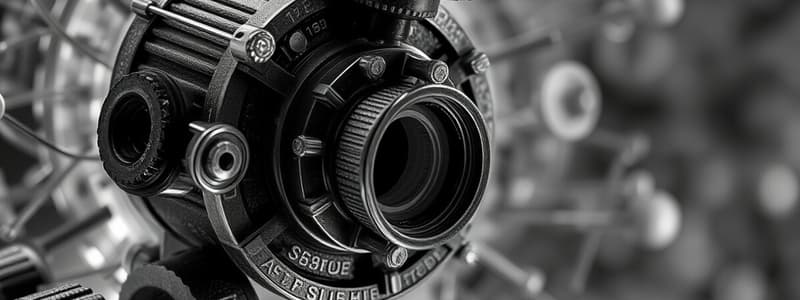Podcast
Questions and Answers
What type of microscope uses electrons to create an image?
What type of microscope uses electrons to create an image?
- Transmission Electron Microscope (TEM) (correct)
- Scanning Electron Microscope (SEM) (correct)
- Light Microscope
- Compound Microscope
Prokaryotic cells have a nucleus.
Prokaryotic cells have a nucleus.
False (B)
What organelle is responsible for energy production in eukaryotic cells?
What organelle is responsible for energy production in eukaryotic cells?
Mitochondrion
The ________ is a structure that regulates the entry and exit of substances in and out of the cell.
The ________ is a structure that regulates the entry and exit of substances in and out of the cell.
Match the following cell organelles with their functions:
Match the following cell organelles with their functions:
Flashcards
Scanning Electron Microscope (SEM)
Scanning Electron Microscope (SEM)
A microscope that uses a focused beam of electrons to create high-resolution images of a specimen's surface morphology and texture.
Transmission Electron Microscope (TEM)
Transmission Electron Microscope (TEM)
A microscope that utilizes a beam of electrons to visualize the internal structures of a specimen at extremely high magnification.
Prokaryotic Cells
Prokaryotic Cells
Cells that lack a nucleus and membrane-bound organelles. These cells are generally smaller and simpler than eukaryotic cells.
Eukaryotic Cells
Eukaryotic Cells
Signup and view all the flashcards
Nucleus
Nucleus
Signup and view all the flashcards
Study Notes
Scanning Electron Microscope (SEM)
- SEM provides high-resolution images by using a focused beam of electrons.
- It is used for surface morphology and texture analysis of specimens.
History of the Microscope
- The development of microscopes has seen significant evolution over centuries.
- Early microscopes included the basic compound microscope, culminating in advanced types like electron microscopes.
Types of Electron Microscopes
- Transmission Electron Microscope (TEM) allows for viewing internal structures at extremely high magnification.
- Electron microscopes contrast structural details invisible to light microscopes, revealing cellular and sub-cellular features.
Themes of Anatomy and Physiology
- Anatomy studies the structure organs and body parts, while physiology examines their functions and interactions.
- Both fields are essential for understanding the complexity of living organisms.
Principles of Cell Theory
- All living organisms are composed of one or more cells.
- Cells are the basic unit of life and arise from pre-existing cells.
Prokaryotic vs. Eukaryotic Cells
- Prokaryotic cells lack a nucleus and membrane-bound organelles; they are generally smaller and simpler.
- Eukaryotic cells have a nucleus and are complex, with various organelles performing specific functions.
Key Cell Organelles
- Nucleus: Control center of the cell, containing genetic material.
- Ribosomes: Sites of protein synthesis, found in both prokaryotic and eukaryotic cells.
- Mitochondrion: Powerhouse of the cell, responsible for energy production.
- Cytoplasm: Jelly-like substance where organelles are located and cellular processes occur.
- Cytoskeleton: Provides structural support and helps in cell movement.
- Vacuole: Storage organelle; larger in plant cells for maintaining turgor pressure.
- Endoplasmic Reticulum: Site for protein and lipid synthesis; rough ER has ribosomes, smooth ER does not.
- Lysosomes: Contain digestive enzymes to break down waste materials and cellular debris.
- Golgi Apparatus: Modifies, sorts, and packages proteins and lipids for secretion or use within the cell.
- Peroxisome: Breaks down fatty acids and detoxifies harmful substances.
- Vesicles: Small membrane-bound sacs that transport materials within the cell.
Differences Between Plant and Animal Cells
- Plant cells have a rigid cell wall and large central vacuoles, aiding in structure and storage.
- Animal cells lack cell walls and may contain small, temporary vacuoles.
Studying That Suits You
Use AI to generate personalized quizzes and flashcards to suit your learning preferences.



